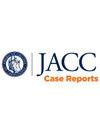Electrical Storm After STEMI Refractory to Medications Successfully Managed With Bilateral Sympathetic Ganglionectomy
Q4 Medicine
引用次数: 0
Abstract
Background
Electrical storm is a life-threatening condition often requiring antiarrhythmics, sedation, antiadrenergics, and hemodynamic support. In refractory cases, cardiac sympathetic denervation can help reduce arrythmia burden and implantable cardioverter-defibrillator shocks.
Case Summary
A 40-year-old man presented with anteroseptal ST-segment elevation myocardial infarction and newly reduced left ventricular ejection fraction and underwent coronary artery bypass grafting during hospitalization. He subsequently developed refractory monomorphic ventricular tachycardia despite treatment with amiodarone, lidocaine, and a left stellate ganglion block. He was successfully treated with bilateral video-assisted thoracoscopic sympathetic ganglionectomy.
Discussion
In patients presenting with electrical storm, particularly those with ischemic cardiomyopathy, bilateral sympathetic ganglionectomy can be an effective treatment when ventricular arrhythmias are refractory to antiarrhythmic drugs and device optimization.
Take-Home Messages
This case highlights that bilateral sympathetic ganglionectomy offers more comprehensive autonomic modulation than unilateral block and may provide definitive control of refractory arrhythmias. Temporary blocks may serve as diagnostic or therapeutic bridges to surgical intervention.
双侧交感神经节切除术成功治疗STEMI后顽固性电风暴
电风暴是一种危及生命的疾病,通常需要抗心律失常、镇静、抗肾上腺素能药物和血流动力学支持。在难治性病例中,心脏交感神经去支配可以帮助减少心律失常负担和植入式心律转复除颤器休克。病例总结:一名40岁男性,因房间隔st段抬高型心肌梗死,新发左室射血分数降低,住院期间行冠状动脉旁路移植术。尽管经胺碘酮、利多卡因和左星状神经节阻滞治疗,他仍出现难治性单型室性心动过速。双侧胸腔镜交感神经节切除术治疗成功。对于以电风暴为表现的患者,特别是缺血性心肌病患者,当室性心律失常对抗心律失常药物和设备优化难以治愈时,双侧交感神经节切除术是一种有效的治疗方法。本病例强调了双侧交感神经节切除术比单侧阻滞提供更全面的自主神经调节,并可能对难治性心律失常提供明确的控制。临时阻塞可作为诊断或治疗的桥梁,以进行手术干预。
本文章由计算机程序翻译,如有差异,请以英文原文为准。
求助全文
约1分钟内获得全文
求助全文
来源期刊

JACC. Case reports
Medicine-Cardiology and Cardiovascular Medicine
CiteScore
1.30
自引率
0.00%
发文量
404
审稿时长
17 weeks
 求助内容:
求助内容: 应助结果提醒方式:
应助结果提醒方式:


